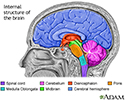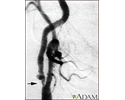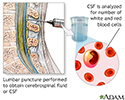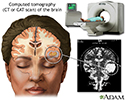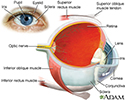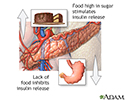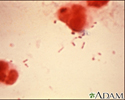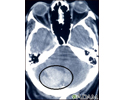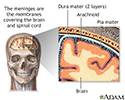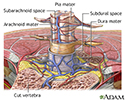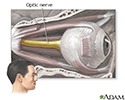Multimedia Gallery
Autism spectrum disorders
Every child has a unique personality. Some are outgoing, while others are shy. But there are certain kids who have trouble dealing with things that most children take in stride. They may not make eye contact or have conversations. They may not like to be touched or to hear loud sounds. If you have a child who acts this way, the problem may be autism.
Why do kids get autism?
Autism is a developmental problem that often becomes noticeable during the toddler years, though it may start earlier. It's significantly more common in premature babies. We know it has to do with abnormal brain biology or chemicals, although the precise mechanism hasn't yet been worked out. Autism appears to be linked both to genes and environmental exposures.
Although the cause of autism is still unclear, doctors do know that the recent increase in autism isn't caused by vaccines. Two leading health organizations, the American Academy of Pediatrics and The Institute of Medicine have studied the issue in depth.. The recommended vaccines don't increase autism; they do prevent serious diseases like measles, tetanus, and diphtheria.
How is autism diagnosed?
More kids are getting diagnosed with autism today than they were a few decades ago. Some of this increase may just be that doctors are testing for it more often now. Children with autism share several characteristics. They may be overly sensitive to sounds, sights, smells, or tastes. For example, a child with autism might refuse to wear anything that's the color blue, or scream when he hears a fire engine siren. Get stuck in routines--a child with autism may want to brush his teeth at exactly 9 a.m. every morning, and get upset if he hasn't brushed them by 9:05. They may prefer to play alone, have trouble talking to people and making eye contact. They may also perform the same motions over and over again, such as waving their arms. Lastly, they may be much quieter than other kids his or her age.
Doctors can diagnose autism with one or more screening tests. These tests evaluate the child's ability to talk, move, and think.
Because each child with autism is different, treatment is tailored to the child. Programs like applied behavioral analysis that can help kids learn the skills they need to be more independent. Medicines can treat specific symptoms that are common in kids with autism, like aggression, hyperactivity, and trouble sleeping.
Some kids with autism may respond well to a gluten- or casein-free diet. Gluten is found in breads and other foods that contain wheat, rye, or barley. Casein is an ingredient in dairy products. Talk to a dietitian before making any changes to your child's diet.
It's fine to try different autism treatments, but watch out for any program that claims to be a miracle, or a cure. Anything that sounds too good to be true probably is.
Autism treatment has come a long way. Decades ago, kids with autism were put away in institutions. Today, they're treated with the goal of becoming independent, functioning adults. If you're worried that your child is showing signs of autism, call your doctor. Get a diagnosis so you can start your child on treatment as soon as possible.
Autism spectrum disorders
Review Date: 4/6/2025
Reviewed By: Neil K. Kaneshiro, MD, MHA, Clinical Professor of Pediatrics, University of Washington School of Medicine, Seattle, WA. Also reviewed by David C. Dugdale, MD, Medical Director, Brenda Conaway, Editorial Director, and the A.D.A.M. Editorial team.
Animations
- Alzheimer disease
- Alzheimer disease
- Asperger syndrome
- Atherosclerosis
- Athetosis resulting from ba...
- Attention deficit hyperacti...
- Autism spectrum disorders
- Bladder function - neurolog...
- Brain components
- Cerebral aneurysm
- Cerebral palsy
- Cholesterol and triglycerid...
- Cluster headache
- Concussion
- Concussion
- Diabetes
- Epilepsy
- Epinephrine and exercise
- Erection problems
- Essential hypertension
- Feeling pain
- Hardening of arteries
- Head injury
- Herniated disk
- Herniated nucleus pulposus ...
- How to use a pill cutter
- Hypertension - overview
- Insomnia
- Migraine
- Multiple sclerosis
- Neck pain
- Nerve conduction
- Parkinson disease
- Sciatica
- Seizures
- Shingles
- Sleep disorders
- Spinal stenosis
- Stroke
- Stroke
- Stroke - secondary to cardi...
- Systemic lupus erythematosus
- Tension headache
- Understanding cholesterol r...
- Urinary incontinence
Illustrations
- 15/15 rule
- Active vs. inactive muscle
- Acupuncture
- Adult dermatome
- Alcoholic neuropathy
- Alpha-glucosidase inhibitors
- Alzheimer disease
- Amebic brain abscess
- Amyloidosis of the fingers
- Arterial plaque build-up
- Arterial tear in internal c...
- Arteries of the brain
- Atherosclerosis
- Atherosclerosis of internal...
- Autonomic Nerves
- Balance receptors
- Before and after hematoma repair
- Bicycle helmet - proper usage
- Biguanides
- Blood pressure
- Blood pressure check
- Blood test
- Blood test
- Bone graft harvest
- Brain
- Brain
- Brain and nervous system
- Brain herniation
- Brain structures
- Brain wave monitor
- Brainstem function
- Brudzinski's sign of meningitis
- Calories and fat per serving
- Carotid dissection
- Carotid duplex
- Carotid stenosis - X-ray of...
- Carotid stenosis - X-ray of...
- Carpal tunnel surgical procedure
- Carpal tunnel syndrome
- Cataract - close-up of the eye
- Cauda equina
- Cause of headaches
- Causes of secondary headache
- Central nervous system
- Central nervous system
- Central nervous system and ...
- Cerebellum - function
- Cerebral aneurysm
- Cerebral aneurysm
- Cerebrospinal fluid leak
- Cervical spondylosis
- Cervical vertebrae
- Cholesterol
- Cholesterol producers
- Circle of Willis
- Common peroneal nerve dysfu...
- Complex carbohydrates
- Compression fracture
- Compression of the median nerve
- Concussion
- Congenital toxoplasmosis
- Copper urine test
- Coronary artery blockage
- Craniotomy for cerebral shunt
- Creutzfeldt-Jakob disease
- Crossed eyes
- CSF cell count
- CSF chemistry
- CSF protein test
- CT scan
- CT scan of the brain
- Damaged axillary nerve
- DASH diet
- Developmental process of at...
- Diabetes and exercise
- Diabetes and nerve damage
- Diabetic blood circulation ...
- Diabetic emergency supplies
- Diabetic retinopathy
- Ear anatomy
- Effects of age on blood pressure
- Electromyography
- Endarterectomy
- Endocrine glands
- Enlarged view of atherosclerosis
- Exercise can lower blood pr...
- External and internal eye a...
- Eye
- Eye ultrasound
- Facial drooping
- Femoral nerve damage
- Fibromyalgia
- Fish in diet
- Food and insulin release
- Forward bend test
- Glaucoma
- Glossopharyngeal neuralgia
- Glucose in blood
- Glucose test
- Grand mal seizure
- Gray and white matter of th...
- Haemophilus influenzae organism
- Head injury
- Head trauma
- Headache
- Healthy diet
- Herniated disk repair
- Herniated lumbar disk
- Herniated nucleus pulposus
- Herpes zoster (shingles) - ...
- Herpes zoster (shingles) di...
- Herpes zoster (shingles) on...
- Herpes zoster (shingles) on...
- Herpes zoster (shingles) on...
- Herpes zoster (shingles) on...
- Herpes zoster (shingles) on...
- Herpes zoster (shingles) on...
- Herpes zoster (shingles) on...
- High blood pressure tests
- Hunger center in brain
- Hypothalamus
- Increased intracranial pressure
- Indications of head injury
- Insulin production and diabetes
- Insulin pump
- Insulin pump
- Intervertebral disk
- Intracerebellar hemorrhage ...
- Intracerebral hemorrhage
- Intracranial pressure monitoring
- Irregular sleep
- Kernig's sign of meningitis
- Kyphosis
- Late-stage syphilis
- Left cerebral hemisphere - ...
- Leukoencephalopathy
- Lifestyle changes
- Limbic system
- Lobes of the brain
- Location of whiplash pain
- Low blood sugar symptoms
- Lower leg muscles
- Lumbar puncture (spinal tap)
- Lumbar vertebrae
- Lumbar vertebrae
- Lyme disease
- Lyme disease - Borrelia bur...
- Lyme disease - erythema migrans
- Lyme disease organism - Bor...
- Meninges of the brain
- Meninges of the spine
- Migraine cause
- Migraine headache
- Monitoring blood pressure
- Motor nerves
- MRI of the brain
- MRI scans
- Multiple sclerosis
- Muscle cells vs. fat cells
- Muscle fatigue
- Muscle pain
- Muscular atrophy
- Myelin and nerve structure
- myPlate
- Neck pain
- Nerve biopsy
- Nerve conduction test
- Nerve supply to the pelvis
- Nervous system
- Neurofibromatosis I - enlar...
- Normal pupil
- Omega-3 fatty acids
- Optic nerve
- Pain of cluster headache
- Phytochemicals
- Pituitary gland
- Plaque buildup in arteries
- Prevention of heart disease
- Primary brain tumor
- Ptosis - drooping of the eyelid
- Radial nerve dysfunction
- Radiation therapy
- Retina
- Right cerebral hemisphere -...
- Role of the vagus nerve in ...
- Sacrum
- Saturated fats
- Sciatic nerve
- Sciatic nerve damage
- Scoliosis
- Scoliosis
- Scoliosis brace
- Shaken baby symptoms
- Shingles
- Signs of scoliosis
- Simple carbohydrates
- Skeletal spine
- Skull of a newborn
- Skull of an adult
- Sleep patterns in the young...
- Sleep studies
- Slit-lamp exam
- Soluble and insoluble fiber
- Spinal anatomy
- Spinal cord injury
- Spinal curves
- Spinal fusion
- Spinal stenosis
- Spinal stenosis
- Spinal tumor
- Spine supporting structures
- Stroke
- Subdural hematoma
- Subdural hematoma
- Substantia nigra and Parkin...
- Sulfonylureas drug
- Systemic lupus erythematosus
- Tension-type headache
- Thiazolidinediones
- Thoracic outlet anatomy
- Tibial nerve
- Tick - deer engorged on the skin
- Tick, deer - adult female
- Torticollis (wry neck)
- Trans fatty acids
- Transient Ischemic attack (TIA)
- Tympanic membrane
- Type I diabetes
- Ulnar nerve damage
- Ultrasound, normal fetus - ...
- Untreated hypertension
- Vascular headaches
- Ventricles of the brain
- Vertebra and spinal nerves
- Vertebra, cervical (neck)
- Vertebra, lumbar (low back)
- Vertebra, thoracic (mid back)
- Vertebrae
- Vertebral column
- Vertigo
- Visual acuity test
- Visual field test
- Vitamin B6 benefit
- Vitamin B6 source
- Voiding cystourethrogram
- Weight loss
- Whiplash
- Wrist anatomy
- X-linked recessive genetic ...
- X-linked recessive genetic ...
- X-linked recessive genetic ...
- X-ray
- Yo-yo dieting
Presentations
- Carotid artery surgery - series
- Carpal tunnel repair - series
- Craniotomy - series
- CSF oligoclonal banding - ...
- Lumbar spinal surgery - series
- Meningocele repair - series
- Microdiskectomy - series
- Monitoring blood glucose - ...
- Spinal fusion - series
- Spinal surgery - cervical -...
- Stroke - series
- Two person roll - series
- Ventriculoperitoneal shunt ...

 Bookmark
Bookmark









































































